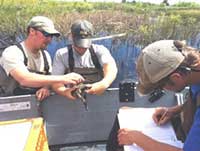(Provided by Michigan DNR)
 DNR Duck Banding Showcased on DiscoveringEfforts by a Michigan DNR crew to band ducks at the Portage Marsh in Delta County were showcased recently on an episode of "Discovering" a weekly outdoors program produced by Brian Whitens and broadcast at on WLUC-TV6, Marquette.
DNR Duck Banding Showcased on DiscoveringEfforts by a Michigan DNR crew to band ducks at the Portage Marsh in Delta County were showcased recently on an episode of "Discovering" a weekly outdoors program produced by Brian Whitens and broadcast at on WLUC-TV6, Marquette.
The duck banding was part of the DNRís goal to manage for sustainable populations of wildlife species. The DNRís objective is to manage game populations to provide hunting and trapping opportunities while maintaining populations in balance with available habitat, land use practices and stakeholder values.
Strategies for meeting this objective include monitoring and assessing game populations annually and conducting research to provide new and synthesized information to make recommendations on hunting regulations and population management.
Minimum mallard, wood duck and Canada goose banding quotas were set in 2015 for four regions across Michigan, totaling 2,450 Canada geese, 2,000 mallards and 1,100 wood ducks. In the Upper Peninsula, the minimum banding quotas were 300 Canada geese and 100 each for mallards and wood ducks.
The 30-minute television program featured DNR wildlife biologist Dusty Arsnoe, wildlife technician Colter Lubben and summer assistant Caleb Eckloff, all from the Escanaba office, trapping, banding and releasing mallards and wood ducks.
"It was a great opportunity to partner with "Discovering" to showcase our duck banding program in the U.P. region," Arsnoe said."ìBrian Whitens did an outstanding job showing the techniques we utilize to capture and identify wood ducks and mallards in Portage Marsh."
Arsnoe said each year the DNR Wildlife Division works cooperatively with other states and Canadian provinces to band ducks and geese within the Mississippi Flyway.
"Participation in this banding program provides valuable information used to estimate bird survival, harvest rates and harvest distribution," Arsnoe said. "These efforts help ensure sustainable management of duck and geese into the future."
Biologists band ducks and geese to help track their movements and determine their annual survival, migration routes and contributions made to the state harvest from various breeding grounds.
Every hunter can promote sound waterfowl management by promptly reporting all banded and/or neck-collared ducks and geese harvested, including date and location taken.
To report bands go online to www.reportband.gov or call 800-327-BAND or write USGS Patuxent Wildlife Research Center, Bird Banding Laboratory, 12100 Beech Forest Road, Laurel, MD 20708-4037.